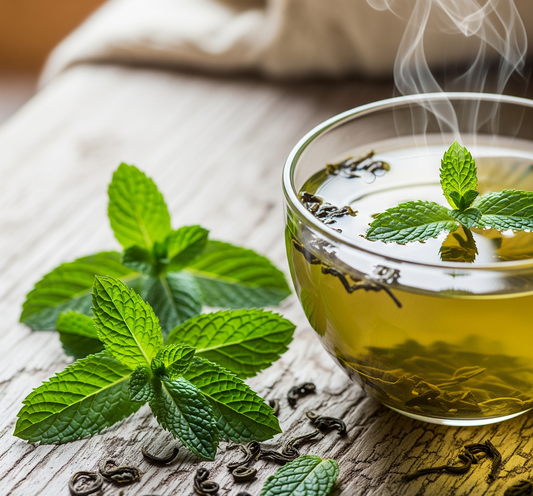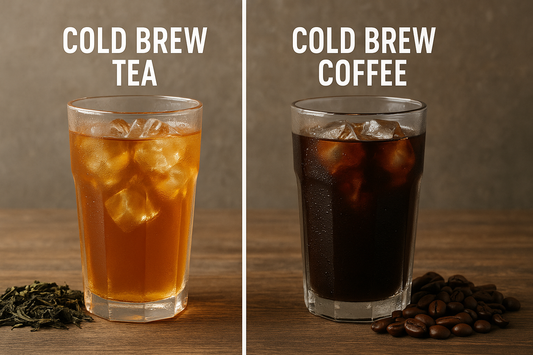White tea is a captivating beverage with exquisite varieties and subtle, refined flavors. It gets its name from the silvery down that covers young tea leaves and needles. Minimally processed, these leaves brew into a pale, elegant elixir with a fresh and mellow taste.
The story of this aromatic brew began in China. Legend has it that during the Song Dynasty, tender buds and young leaves hand-plucked from the Fujian province were presented to the emperor as a token of their respect.
The young, rolled buds with downy silvery fuzz fascinated the emperor. In that time, white tea’s delicate yet complex flavors gained favor among the nobility. This smooth elixir was then prepared ceremonially and offered to the ancient emperors of China as a symbol of honor.
Though white tea is now grown all over the world, including on our tea gardens in the misty highlands of Eastern Nepal, the Fujian Province of China is still known as the home of high-quality white teas. White teas are known to be fresh, and the closest to tea as tea is meant to be enjoyed, with minimal processing involved. However, it takes careful attention and quick skills to be able to make high quality, delicious white teas.
In this blog, we will take you on a journey of how white teas are made, how you should brew white tea, and which white teas are just right for you.
What is White Tea?
What sets white tea apart is its minimal processing, allowing the leaves to express their inherent flavors. Young buds, also called tips or needles, are gently hand-plucked, along with still unrolled leaves. Higher qualities of white teas have a fine, silvery fuzz that is characteristic of young Camellia Sinensis leaves.
The buds and young leaves are then gently withered under the sun or in temperature-controlled rooms. For the preservation of the fine leaves and their delicate flavors, it is important to ensure the leaves don’t have prolonged exposure to oxygen. As they are dried, the leaves take on a pronounced silvery-white appearance.
This gentle processing method retains the tea's delicate flavors, captivating tea enthusiasts with its subtle and nuanced taste profile.
Oxidized Teas vs White Teas: How to Choose?
The first thing lovers of tea come to learn is that all tea – black, green, oolong or white – come from the same plant: Camellia Sinensis. Different cultivars and varieties of this incredible tea plant, along with the climate and soil in which they were cultivated, gives rise to differences in flavor profiles and aromas in your brew.
Additionally different plucking and processing traditions creates different varieties of tea. One main difference in processing among varieties of tea is how much, if at all, the leaves are exposed to oxygen after harvest.
The longer tea leaves are exposed to oxygen – which is the process of oxidation – the darker the leaves become. Flavor profiles of highly oxidized teas, which are black teas, take on a deep, rich color and malty flavors, such as our Kanchanjangha Noir. Green and Oolong teas also go through lower levels of oxidation.
White Teas are simply allowed withered and dried quickly after harvest so as to stop oxidation. While the young, rolled leaves and buds, are also naturally less exposed to oxygen in comparison to leaves that are unfurled, they are also not manually oxidized like black or oolong teas are. This results in white tea’s delicate, subtle flavors, smooth mouthfeel, and flowery aromas.
Discovering the Spectrum of Delight
White tea presents a delightful array of varieties, each with its unique characteristics and flavors.
Silver Needle: Regarded as the pinnacle of white tea, silver needle, or silver tips, is crafted solely from tender buds, delicately plucked and meticulously sorted. Our Silver Yeti is one of such teas, with its pale, silvery appearance. Grown in the tea gardens along the foothills of Mt. Kanchanjangha, Silver Yeti has the unique flavors of stonefruit, sweet hay and buttercream.
Silvery Oolong: Departing from the traditional processing methods of white tea, our White Prakash tea, sometimes called silvery oolong, goes through a couple of hours of natural withering. Afterwards, the young leaves, hand-plucked during spring’s first flush and summer’s second flush, are transferred to a rolling machine for eight to ten minutes. This allows the leaves to release their essential oils, and their fresh, floral aroma fills up the room. This incredible aroma is then locked in and captured through a drying process. This smooth brew has a floral taste, with notes of smooth buttery and vanilla.
White Peony: A true delight for the senses, White Peony combines young buds and leaves. Its flavor profile exhibits a delicate interplay of floral notes with a hint of sweetness, providing a well-rounded and refreshing brew.
Jasmine Silver Needle: Combining the elegance of Silver Needle with the enchanting aroma of jasmine blossoms, this variety infuses the delicate tea leaves with the intoxicating fragrance of jasmine, creating a captivating symphony of flavors and scents.
How to Brew your White Tea?
White teas brew into a lighter elixir with more delicate flavors than black, green or oolong teas. To bring out the subtle and nuanced flavors of white tea best, these delicate leaves and buds need to be prepared with more care and attention than its counterparts.
Step 1: Prepare your kettle...
The neutral flavor of spring water or filtered water is best for brewing white teas. Tap water with high concentrations of copper, zine or chlorine can have a strong metallic flavor that will compete with the delicate flavors of your white tea.
While heating, remove your kettle from the heat before your water reaches boiling point. Ideally, heat your water to 180F, or bring your water to a boil and let it cool down for about five to ten minutes. We do not advice pouring boiling hot water over your white tea leaves, since that could disturb its flavor and aroma.
Step 2: Measure out your leaves...
Use 2 grams of Silver Yeti for every 8 ounces of water. If you're brewing a blend of silver needles and loose-leaf white teas such as our tea White Prakash, you can also use 2 grams of our orthodox tea for every 8 ounces of water, however steeping times vary for various depths of flavor.
Step 3: Let it brew...
Let your white tea leaves steep in your teapot, mesh or cup infuser of your choosing. For ease of brewing, we recommend our Wall Tea infuser, in which you can brew your leaves right in your teacup with no hassle of clean up afterwards. You can serve your tea after 4 minutes of brewing and savor its smooth and delicious flavors.
If you enjoy several cups of tea throughout your day, we advise you not to waste your tea leaves and let your batch of leaves re-steep. Our white teas are potent with aroma and flavor and can be re-steeped several times with an added minute each time.
The Benefits of White Tea
Beyond its exquisite taste, white tea offers a range of health benefits that further enhance its allure. Rich in antioxidants, white tea is known for its potential to support a healthy immune system, promote radiant skin, and is said to aid in weight management. Its lower caffeine content compared to other teas makes it a soothing choice for those seeking a gentle yet invigorating beverage to enjoy throughout the day.
Embark on Your White Tea Adventure...
As we conclude our enchanting journey into the realm of white tea, we invite you to indulge in this delicate brew. Reserved for nobility in the ancient world, white tea is now savored by those who want to experience tea leaves in their finest essence. Whether you're a seasoned tea connoisseur or new to the world of tea, white tea's delicate flavors and captivating history beckon you to indulge in moments of tranquility and pure bliss.




